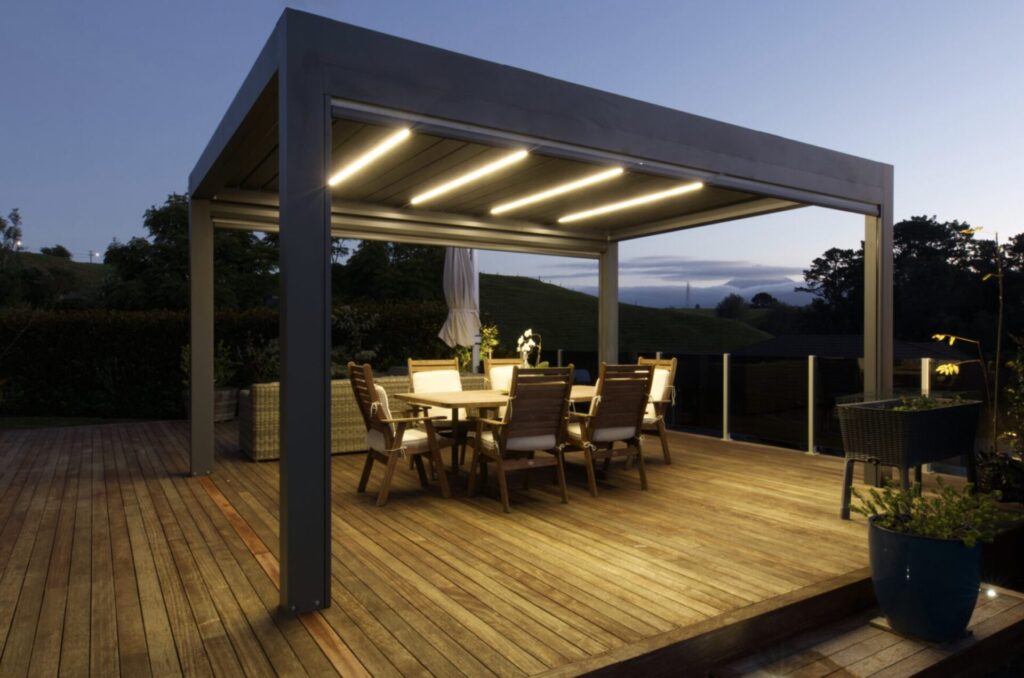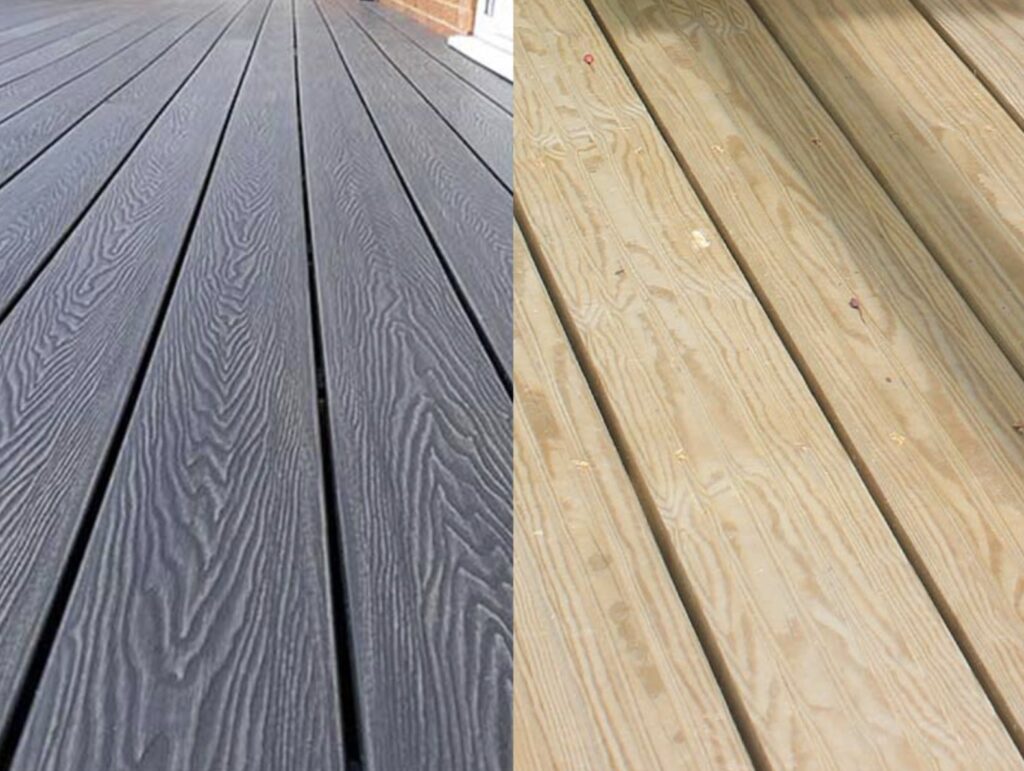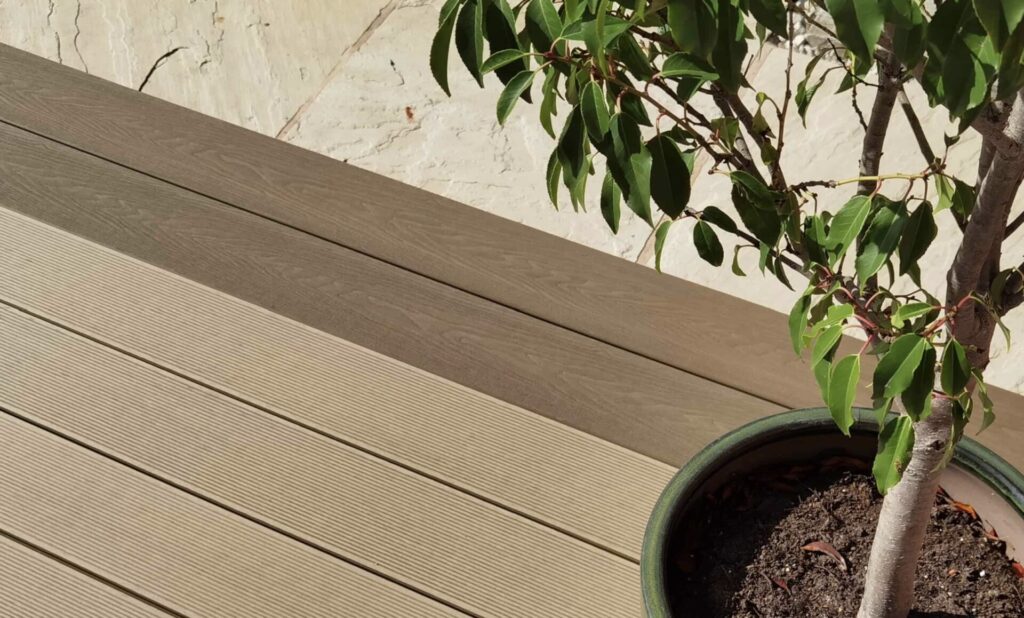Creating a beautiful and functional outdoor pergola involves many considerations, from design and location to the choice of materials. One of the most crucial decisions you’ll make is selecting the right timber, as it influences both the aesthetic appeal and structural integrity of your pergola. Let’s explore some of the best timber options for outdoor pergolas, each with its unique qualities and benefits.
Table of Contents
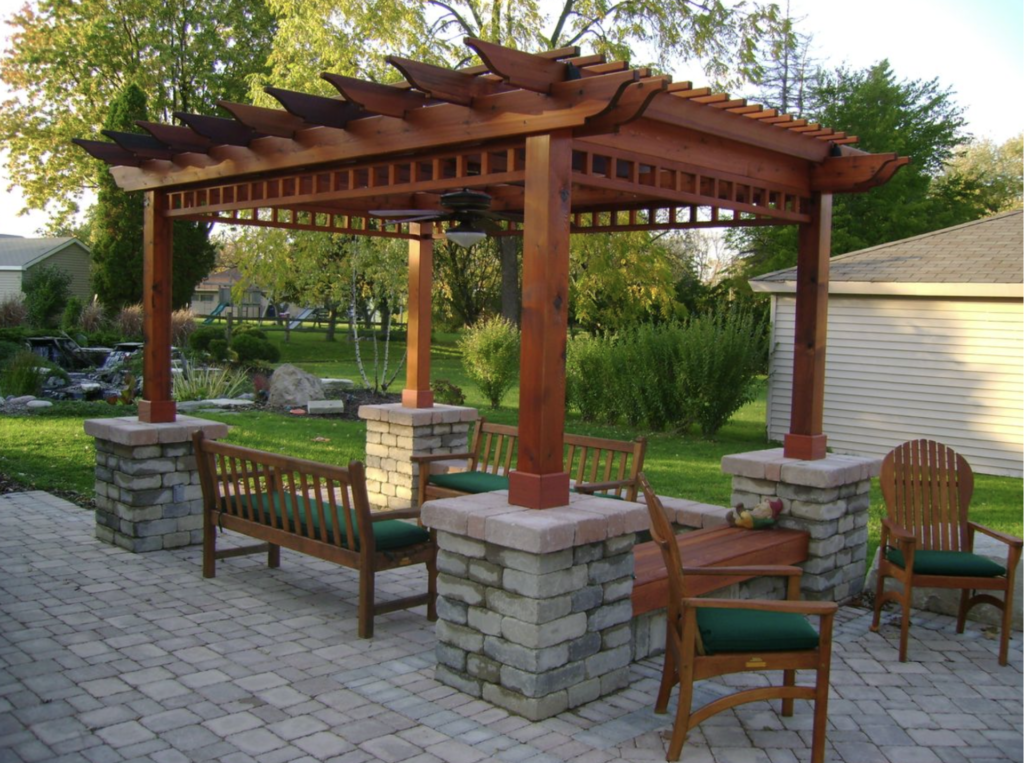
Western Red Cedar Pergolas: The Aromatic Naturalist
Western Red Cedar, known scientifically as Thuja plicata, is a wood species native to the Pacific Northwest of the United States and Canada and is esteemed for its exceptional natural beauty and outstanding physical properties. Its heartwood displays a rich tapestry of warm reddish-brown tones intermixed with lighter amber hues, which gracefully age to a distinguished silvery-gray patina if left untreated.
The wood is also graced with a subtle and pleasant aroma, adding a sensory experience to its aesthetic appeal. This characteristic cedar scent is not only pleasing but serves as a natural deterrent to insects, making the lumber even more ideal for outdoor use.
The physical attributes of Western Red Cedar make it an exceptional choice for outdoor structures like pergolas. It has a cellular structure that provides natural insulation, keeping the environment under the pergola cooler in summer and warmer in winter.
Furthermore, this wood is inherently resistant to decay, moisture absorption, and fungal growth, which, combined with its dimensional stability, means it is less likely to warp or crack compared to other wood species. This durability, coupled with its lightweight nature, makes Western Red Cedar not just a visually appealing option but a practical one for long-lasting outdoor construction.
Whether for its classic beauty or its resilience to the elements, Western Red Cedar stands as a superior selection for crafting a pergola that can be enjoyed for many years.
Characteristics
- Color: Rich reddish-brown
- Durability: Naturally resistant to decay and insects
- Maintenance: Requires staining or oiling to maintain color
- Workability: Lightweight and easy to work with
Pros and Cons
Pros:
- Attractive appearance with a unique aroma
- High resistance to rot, decay, and insect infestations
- Relatively lightweight, making it easy to install
Cons:
- More expensive compared to some other timber options
- Soft nature may lead to scratches or dents if not carefully maintained
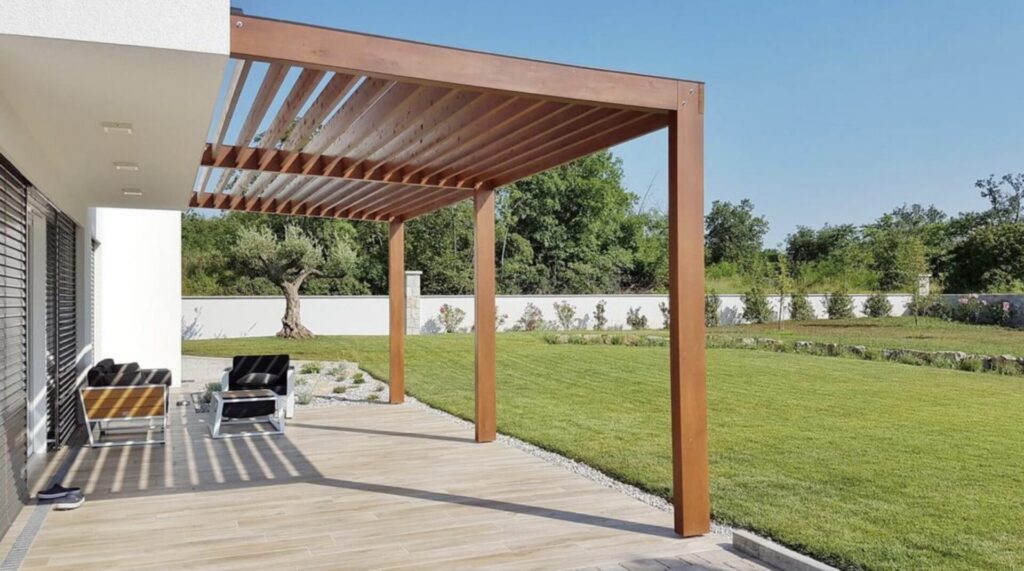
Treated Pine Pergolas: The Affordable and Versatile Option
Treated Pine is a widely used timber for outdoor constructions, especially favored for its affordability and availability. This softwood, typically sourced from plantation forests, undergoes a pressure treatment process where it’s infused with preservatives, enhancing its resistance to decay, insects, and fungal infection.
This treatment extends the life of pine, which otherwise, due to its softer nature, would be more susceptible to outdoor elements.
The preservatives used are designed to penetrate deep into the wood, providing thorough protection which is particularly beneficial for structures like pergolas, which are constantly exposed to weather variations.
Visually, Treated Pine has a light, clean appearance, presenting a blank canvas that can be finished to suit any style or preference. It accepts paint and stain well, allowing homeowners to customize their pergola’s look to match their outdoor décor or personal taste.
Over time, if left untreated, Treated Pine will weather to a silver-gray color, similar to many other woods, but the structural integrity will remain due to the treatment. The versatility of Treated Pine makes it an excellent choice for those who desire a balance between cost-effectiveness and durability.
When considering the use of Treated Pine for a pergola, it’s important to factor in the maintenance regimen, which will likely include periodic sealing or staining to maintain its appearance and maximize its lifespan.
Characteristics
- Color: Pale yellow to light green, can be stained or painted
- Durability: Enhanced with chemical treatments
- Maintenance: Regular sealing and staining recommended
- Workability: Easy to cut and install
Pros and Cons
Pros:
- Cost-effective for those on a tight budget
- Versatile and can be painted or stained to match any style
- Generally resistant to decay and insects due to treatment
Cons:
- Treatment with chemicals is necessary for durability
- May warp or crack over time if not properly maintained

Redwood Pergolas: The Elite and Aesthetic
Redwood, renowned for its stunning natural beauty and durability, is a superior choice for outdoor structures like pergolas. This lumber, harvested from the Sequoia sempervirens, is inherently rich in color, ranging from a light pink to a deep reddish-brown, which can add an air of elegance and warmth to any garden or outdoor living space.
The prominent feature of Redwood is its resistance to rot, decay, and insect infestation, attributes owed to the natural tannins and oils present within the wood.
These protective qualities make it an excellent material for long-lasting outdoor applications without the need for as many chemicals or treatments as other woods might require.
Another notable advantage of Redwood is its dimensional stability. It has a low shrinkage rate, which means it retains its shape and size well over time despite the fluctuations in weather, an essential characteristic for the structural integrity of a pergola.
When left to age naturally, Redwood gracefully weathers to a soft gray hue, maintaining its resilience. For those wishing to preserve the wood’s original splendor, a light application of a UV-inhibiting sealant can help maintain its color, while also offering additional protection from the elements.
Redwood’s combination of beauty, durability, and resistance to weathering makes it an ideal, albeit sometimes pricier, choice for those looking to invest in a premium, long-lasting outdoor pergola.
Characteristics
- Color: Warm reddish tones
- Durability: Naturally resistant to decay and insects
- Maintenance: Less frequent compared to other woods
- Workability: Fairly easy, though harder than cedar
Pros and Cons
Pros:
- Offers a distinct and upscale look with a natural finish
- High resistance to the elements with minimal upkeep
- Less prone to warping and checking compared to other woods
Cons:
- More costly than many other timber types
- Can be difficult to source, which might drive up costs further
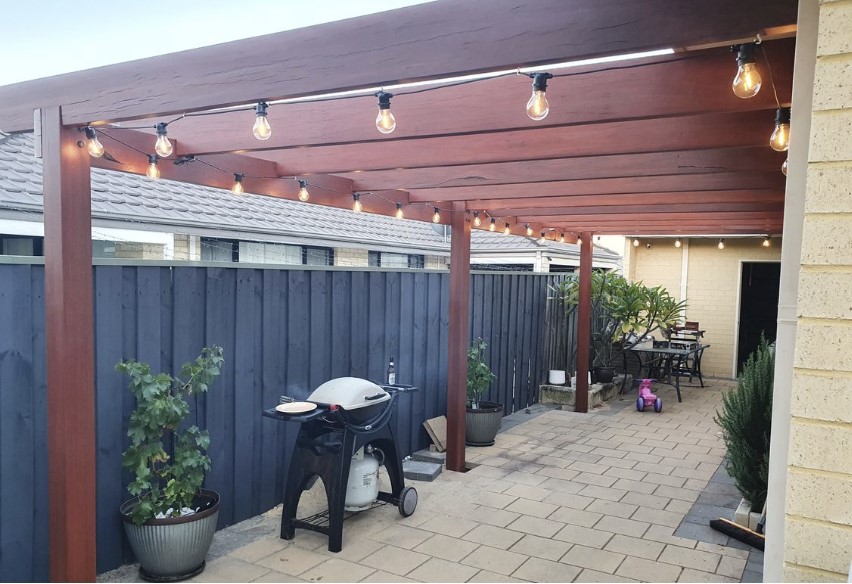
Jarrah Pergolas: The Down Under Durability Champion
Jarrah, a highly esteemed Australian hardwood, is widely recognized for its remarkable resilience and aesthetic appeal, making it an excellent choice for outdoor pergolas. Extracted from Eucalyptus marginata trees in the forests of Western Australia, Jarrah boasts a rich, dark red hue that deepens over time, infusing any pergola with an air of sophistication and warmth.
This hardwood is particularly valued for its density and toughness, which provide an exceptional resistance to the elements, insects, and decay, factors that are crucial for the longevity of outdoor timber structures.
The toughness of Jarrah does not only contribute to its durability but also means it can withstand considerable wear and tear, a quality that is particularly beneficial in high-traffic areas or commercial settings where a pergola may be subject to frequent use.
Moreover, its natural oils preserve the wood, enabling it to maintain its integrity without the need for excessive treatments. For those aiming to retain Jarrah’s striking initial appearance, it is recommended to treat the wood with a suitable sealant, which will not only enhance its natural coloration but also protect it against UV radiation and moisture.
However, should a more subdued look be desired, allowing Jarrah to age without intervention will result in a distinguished, silvery-grey finish. Its combination of aesthetic appeal and resilience makes Jarrah an investment-worthy material for pergolas, offering both visual pleasure and practical durability.
Characteristics
- Color: Dark red to brown
- Durability: Highly resistant to decay, termites, and harsh weather
- Maintenance: Low maintenance due to natural oils
- Workability: Dense and heavy, requiring more effort to work
Pros and Cons
Pros:
- Extremely durable and long-lasting
- Natural resistance to insects and decay
- Aesthetic appeal with a range of dark tones
Cons:
- High cost, especially outside of Australia
- Heavy and tough, which can make installation challenging
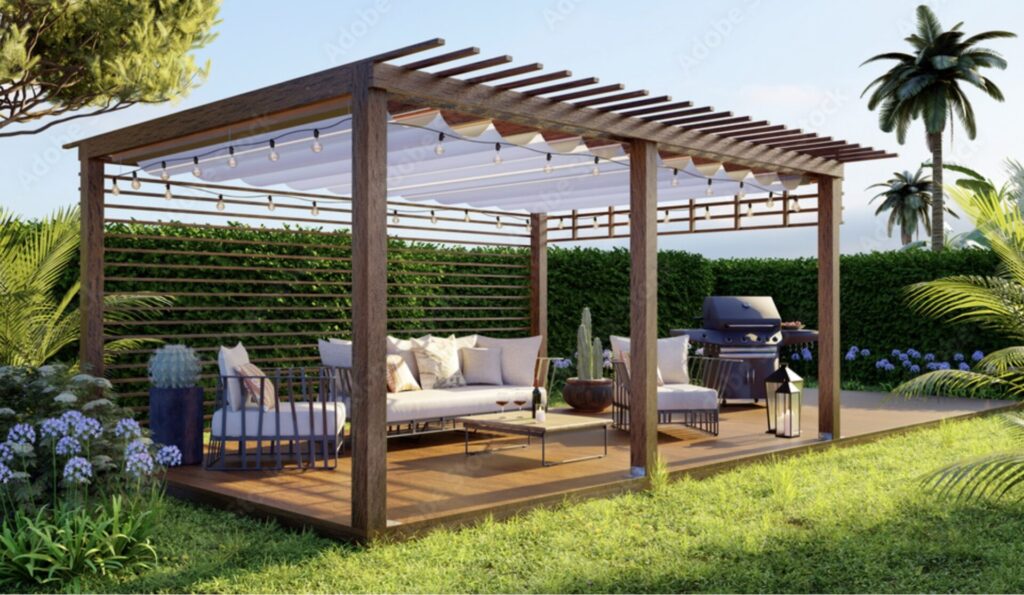
Teak Pergolas: The Exotic Low-Maintenance Choice
Teak is revered as one of the most luxurious and durable materials for outdoor construction, including pergolas. Native to South and Southeast Asia, teak wood (from the species Tectona grandis) is highly sought after for its exceptional qualities that are well-suited to outdoor conditions. It is often regarded as the premier choice for high-end outdoor furniture and structures due to its natural oils and tight grain, which provide robust resistance against rot, fungal decay, and insect infestations.
Teak’s naturally occurring oils serve as its own protective barrier, negating the need for additional chemical treatments or sealants. This intrinsic oil content not only fortifies the wood against the invasion of pests but also helps to preserve the wood’s fibers, preventing drying out, cracking, or warping that is common in lesser-grade woods when exposed to varying weather conditions.
Over time, if left untreated, teak will gracefully transition from its original golden-brown color to a distinguished silvery-gray patina that many find equally appealing. This aging process does not undermine the structural integrity or durability of the wood, making teak a low-maintenance option for pergola construction.
Moreover, teak is highly regarded for its strength and ability to withstand the rigors of changing climates, which makes it an ideal choice for year-round outdoor environments. Its aesthetic appeal and enduring nature make it a worthwhile investment for those seeking a material that will offer a lifetime of enjoyment and function with minimal care, rendering a teak pergola an elegant and practical addition to any outdoor space.
Characteristics
- Color: Golden to medium brown, aging gracefully over time
- Durability: Excellent resistance to rot and pests
- Maintenance: Low; can be left to weather naturally
- Workability: Easy to work despite its hardness
Pros and Cons
Pros:
- Requires little to no maintenance over its lifetime
- High natural oil content repels water and pests
- Retains strength and integrity for years
Cons:
- Among the most expensive wood options
- Environmental concerns due to over-harvesting
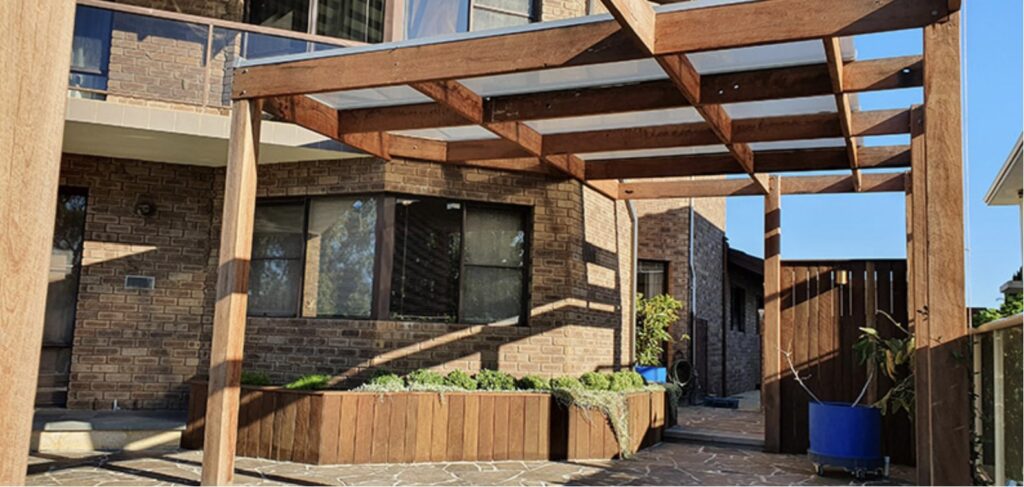
Ironbark Pergolas: The Indestructible Beauty
Ironbark timber stands as a paragon of durability and strength in the realm of outdoor construction, including pergola designs. Indigenous to Australia, Ironbark is a term commonly used to describe a range of Eucalyptus species noted for their hard, dense wood.
This characteristic hardness not only provides an exceptional lifespan but also grants the timber a natural resilience against external pressures such as pests and weather, which is pivotal for structures exposed to the elements.
The wood’s resilience is further enhanced by its innate ability to resist fire, making it a choice material in regions prone to wildfires. Beyond its functional merits, Ironbark timber boasts a rich array of hues, from deep reds to earthy browns, which can imbue any pergola with a warm, inviting ambiance.
As it weathers, Ironbark maintains its robust integrity while its color mellows to a more subdued tone, offering a visual testimony to its age and endurance. Its minimal maintenance requirements and the ability to stand firm against the harsh tests of time and climate make Ironbark an investment in lasting beauty and function for outdoor living spaces.
Characteristics
- Color: Deep reds and browns
- Durability: Extremely high resistance to decay and pests
- Maintenance: Low; its density provides natural protection
- Workability: Challenging due to its hardness
Pros and Cons
Pros:
- Almost indestructible with an incredibly long lifespan
- Beautiful deep color that can enhance any garden setting
- Resistant to fire, pests, and decay
Cons:
- Can be more expensive due to its durability and density
- Hardness makes it difficult to cut and work with, requiring professional tools
How To Protect Your Pergola Wood Choice
A little maintenance can help your pergola beams last longer and maintain a vibrant look. Most wood species turn gray or silver as they age. This can offer a regal look, or it can diminish the vibrance of the structure.
Consider staining, sealing, or painting your pergola to maintain a beautiful appearance. Explore each option and consider your design goals before selecting a species.
Staining Your Pergola
Stains come in solid, semi-transparent, and clear options. A clear stain protects the wood while maintaining as much of the natural tone as possible. Solid stains, however, color the material to offer a totally new look.
Cedar, oak, and tropical hardwood don’t require any stains. Some pergola owners choose to stain cedar for an altered color. Pressure-treated pine can be stained to increase its lifetime.
Sealing Your Pergola
Sealants come in similar options, and many brands offer a combination of stain and sealant. A sealer coat typically doesn’t penetrate or alter the color as much as a stain. Consider sealing your pressure-treated pine or oak pergola, but a sealant is optional for cedar or tropical hardwood.
Pergola Painting
Some homeowners love the natural beauty of wood, but there’s no shame in wanting a little color in your outdoor entertainment or relaxation area. Any wood can be painted to match your home or provide an accent color.
Be sure to choose an outdoor-rated wood paint before you proceed. Some paint brands recommend a sealer coat to prevent fading or peeling. Be sure your pressure-treated wood is fully dry before painting. This can take up to four months depending on when it was treated and your location.
FAQs on Timber for Outdoor Pergolas
What is the best type of timber for an outdoor pergola?
The best type of timber for an outdoor pergola depends on various factors including climate, budget, and personal preference. Durable hardwoods like teak, ipe, or mahogany are excellent for their longevity and resistance to decay. Softwoods like treated pine are more cost-effective but may require more maintenance.
How often should I maintain my timber pergola?
It is generally recommended to inspect your pergola annually and perform any necessary maintenance, such as cleaning, staining, or re-sealing, to protect the wood from the elements. The exact frequency will depend on the type of wood and the climate in your area.
Can I build a pergola with untreated wood?
It’s not advisable to use untreated wood for outdoor structures exposed to the elements. Untreated wood is prone to rot, decay, and insect infestation. If you prefer untreated looks, choose a naturally resistant timber and apply a clear sealant for protection.
Is it necessary to stain or seal my pergola?
While not always necessary, particularly for certain types of hardwoods, staining or sealing can extend the life of your pergola by providing additional protection against the weather and UV light. The choice often depends on the type of wood used and the desired aesthetic.
What are the environmental considerations when choosing timber for pergolas?
Opt for woods certified by organizations like the Forest Stewardship Council (FSC) to ensure that they are sourced from responsibly managed forests. Also, consider local or recycled timber to reduce the environmental impact.
Can I use composite materials for building a pergola?
Yes, composite materials can be used for building pergolas. They offer the advantage of being low maintenance and resistant to rot, but they lack the natural appearance and may be more expensive than timber.
Will a pergola add value to my home?
A well-constructed pergola can add aesthetic appeal and functional outdoor space to your home, which can increase its overall value. The amount of value added can vary depending on the quality of the construction and materials used.
How does the climate affect my choice of timber for a pergola?
Some timbers are better suited to certain climates than others. For example, hardwoods with natural oils like teak or cedar are better in wetter climates as they resist rot, while softwoods may be adequate in drier, less demanding climates.
Are there any timbers to avoid for outdoor use?
Avoid using non-durable softwoods that haven’t been properly treated for outdoor use as they won’t stand up to the elements. Always choose timber that is rated for outdoor use to ensure your pergola lasts.
How do I protect my pergola from termites and other insects?
Using wood that is naturally resistant to insects, such as cedar, teak, or treated timbers, is the best way to protect against pests. Regular inspections and treatments with appropriate wood preservatives can also help prevent infestations.
Final Thoughts
In summary, when selecting timber for your outdoor pergola, consider the climate, the desired maintenance level, and of course, your budget. Western Red Cedar and Redwood offer natural beauty with less maintenance, Treated Pine is cost-effective and versatile, Jarrah and Ironbark provide exceptional durability, and Teak stands out for its low maintenance needs and luxurious appeal. Whatever your choice, ensure it aligns with your vision for the outdoor space to create the perfect pergola retreat.
If you need a pergola in Nelson, give us a call today!
